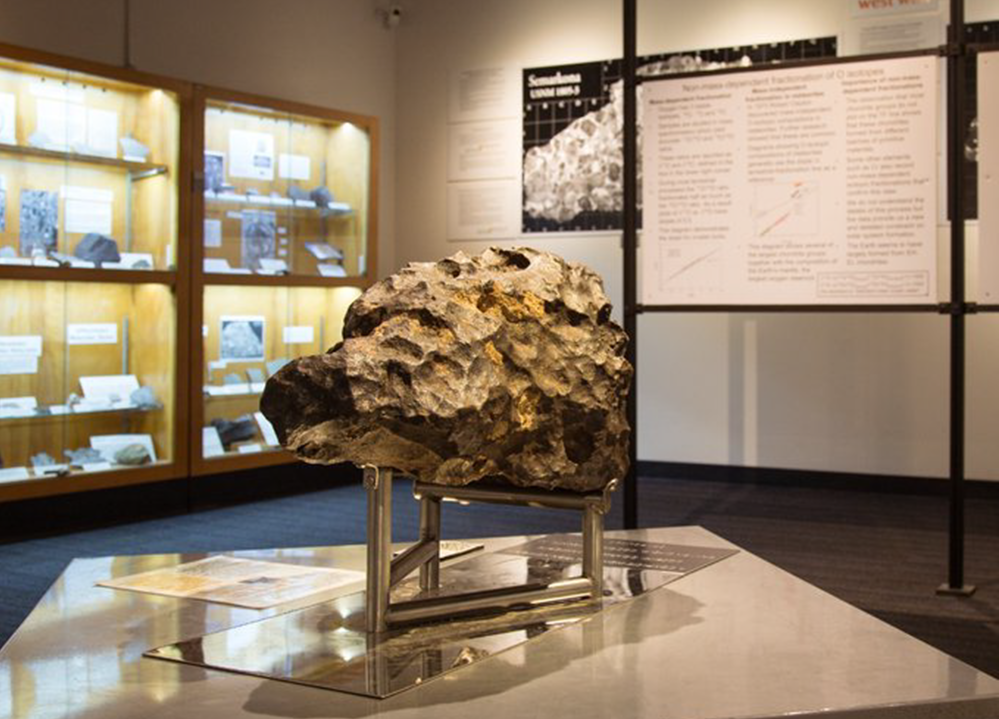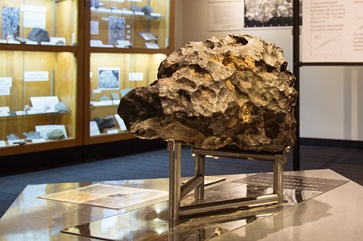The UCLA Meteorite Gallery poetry contest awaits your stellar verse
Help celebrate the study of these formerly heavenly bodies

Roses are red, violets are blue, the UCLA Meteorite Gallery’s poetry contest is waiting for you.
Jonathan Riggs | May 17, 2023
Growing up in Chicago, Alan Rubin remembers being 5 years old and perching on a half-ton meteorite at a local museum.
“Meteorites are the only direct tangible connection with outer space that we have on Earth,” says Rubin, who is now the curator of the UCLA Meteorite Collection as well as a retired and recalled adjunct professor of Earth, planetary, and space sciences at UCLA. “From that first moment on, I knew they were cool.”
To better explain why, here’s a quick science lesson. The rocky and metallic objects known as asteroids orbit the sun along with comets, which are made mainly of ice and dust. Smaller pieces that break off asteroids or comets — or even off of planets or moons — are called meteoroids. Once these meteoroids enter Earth’s atmosphere, they produce the light phenomenon known as meteors or shooting stars — but only those objects that survive the burn and hit the Earth itself qualify as meteorites.
A cosmic journey of such magnitude deserves a fitting tribute, and so in 2021 Rubin launched the UCLA Meteorite Gallery Poetry Contest, where enthusiasts can submit a poem in any form on a meteorite-related topic. This year’s contest ends May 31; the top 10 poems will be published on the Gallery’s website, and the top three will be posted in the Gallery itself. (Send your submissions directly to Rubin.)
“It’s a win-win: we get some nice, clever poems about meteorites that help further our mission of public outreach in terms of getting people more interested in meteorite research,” Rubin says. “It’s also fitting to pay poetic respects to them — meteorites are the building blocks of the solar system and contain the oldest objects formed in it. And we have some you can actually touch.
Poetic Inspiration
For the entirety of human history, meteorites have sparked our imagination and works of art, including more recently the stories of H.P. Lovecraft and, of course, the 1958 science fiction film “The Blob.” Here’s hoping the following meteorite facts from Alan Rubin will stir your creativity and curiosity:
1. Meteorites formed under a wide range of redox conditions and contain many minerals not found on Earth.
2. Meteorites are the building blocks of the planets.
3. Meteorites likely delivered raw materials (e.g., water, organics, phosphorus) to the early Earth, possibly helping to facilitate the origin of life.
4. CI carbonaceous chondrites provide the cosmic abundances of non-volatile elements.
5. Collisions of asteroids with the Earth changed the course of evolution.
6. Impact-crater formation by asteroidal collisions is the predominant geomorphological process in the solar system.
7. The existence of iron meteorites supported the idea that the Earth has an iron core.
8. Meteorites provide clues to the geological history of asteroids.
9. Lunar meteorites come from the entire lunar globe, enhancing our understanding of the geology of the moon.
10. Martian meteorites allow us to study the geological history of Mars.
11. Ancient refractory inclusions in chondritic meteorites yield the age of the solar system.
12. Presolar grains—matter that existed before our sun was formed—in chondritic meteorites permit the in-situ examination of materials from other stars.
13. For some technologically primitive peoples, iron meteorites served as the sole source of metallic iron for making tools. Several items, including a dagger found buried with Tutankhamun, were scientifically confirmed to be of meteoritic origin.
14. Meteorite collecting promotes public appreciation of planetary science.
Explore the UCLA Meteorite Gallery online or in person and send your poetry submission by May 31.




